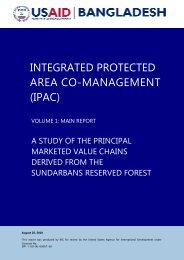Child Equity Atlas - BIDS
Child Equity Atlas - BIDS
Child Equity Atlas - BIDS
You also want an ePaper? Increase the reach of your titles
YUMPU automatically turns print PDFs into web optimized ePapers that Google loves.
<strong>Child</strong> <strong>Equity</strong> <strong>Atlas</strong><br />
3.1 Female Education<br />
3.1.1 Bangladesh has made significant progress<br />
in female education over generations, when<br />
women aged 40-49 years are compared to women<br />
aged 15-24 years. Two-thirds of women aged 40-<br />
49 years have very little or no education, against<br />
only one-fourth of young females (15-24 years)<br />
with similar low levels of educational attainment<br />
(Figure 3.1).<br />
% of female<br />
Figure 3.1: Educational attainment of female<br />
aged 15-24 years and 40-49 years (%),<br />
Bangladesh 2011<br />
70.0<br />
60.0<br />
50.0<br />
40.0<br />
30.0<br />
20.0<br />
10.0<br />
0.0<br />
24.5<br />
68.7<br />
Never to<br />
school &<br />
primary<br />
incomplete<br />
age 15-24 years<br />
25.6<br />
16.3<br />
Primary<br />
completed<br />
Level of<br />
28.6<br />
Secondary<br />
incomplete<br />
on<br />
7.9<br />
age 40-49 years<br />
21.3<br />
7.1<br />
Secondary<br />
completed &<br />
more<br />
This shows a positive inter-generational change<br />
in attitude and practice towards education. A<br />
similar pattern is shown when the proportion<br />
of young (15-24 years) versus adult females (40-<br />
49 years) who complete secondary or higher<br />
educational levels are compared and contrasted<br />
with 21.3 per cent of younger females attaining<br />
higher education compared to only 7.1 per cent<br />
of adult women. This confirms the significant<br />
improvement in female education in the country<br />
over the last couple of decades, a remarkable<br />
achievement by Government and stakeholders<br />
who have sustained commitment to the sector.<br />
3.2 Adult Literacy<br />
3.2.1 The adult literacy (15 years and above) rate<br />
in Bangladesh has increased to 53 per cent in 2011<br />
from 47.3 per cent in 2001 (Table 1.2 in chapter<br />
one). The rate of change in adult literacy is low<br />
with an increase of only 5.7 percentage points in<br />
a decade, signifying a lost opportunity to harness<br />
adult literacy into growth and development. There<br />
are, however, sub-national variations in the adult<br />
literacy rates (Figure 3.2), with Barisal division<br />
having the highest proportion of adult literates<br />
(58.5 per cent) and Rangpur division with the<br />
lowest proportions (46.1 per cent). Adult literacy<br />
rates by districts are presented in Maps 3.1 and<br />
3.2 for 2001 and 2011, respectively. The adult<br />
literacy rate is still lower for females (49.2 per<br />
cent) than males (56.8 per cent). The variations<br />
in adult literacy rates at district and upazila (subdistrict)<br />
levels are presented in Maps 3.3 and 3.4<br />
respectively.<br />
Figure 3.2: Adult (15 years and above) literacy rate by administrative divisions,<br />
Bangladesh 2011<br />
Total Rural Urban<br />
Literacy rate (15 years and<br />
above) (%)<br />
80.0<br />
70.0<br />
60.0<br />
50.0<br />
40.0<br />
30.0<br />
20.0<br />
10.0<br />
0.0<br />
73.2<br />
72.1<br />
67.8<br />
68.8<br />
69.5<br />
65.3<br />
63.8<br />
58.5<br />
63.9<br />
55.4 55.9 55.7 51.7 46.8 53.6 50.1 53.0<br />
47.8 47.5<br />
43.8 46.1 43.2 46.6 43.2<br />
Barisal Chiagong Dhaka Khulna Rajshahi Rangpur Sylhet Total<br />
30














